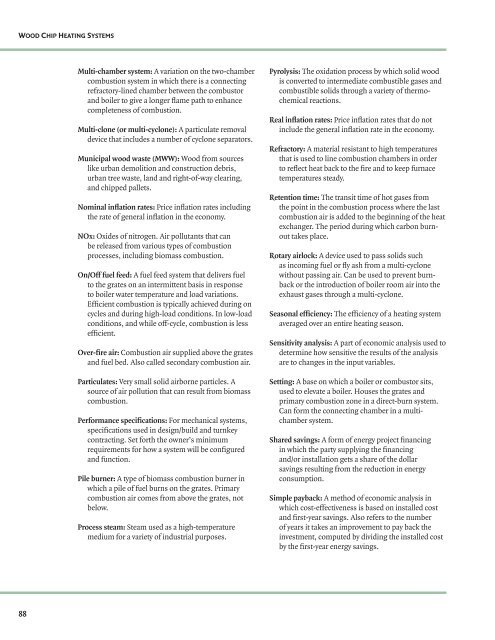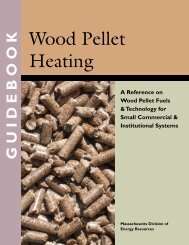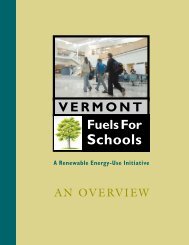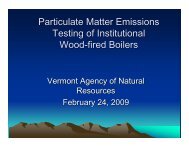Wood-Chip Heating Systems - Biomass Energy Resource Center
Wood-Chip Heating Systems - Biomass Energy Resource Center
Wood-Chip Heating Systems - Biomass Energy Resource Center
You also want an ePaper? Increase the reach of your titles
YUMPU automatically turns print PDFs into web optimized ePapers that Google loves.
WOOD CHIP HEATING SYSTEMS<br />
88<br />
Multi-chamber system: A variation on the two-chamber<br />
combustion system in which there is a connecting<br />
refractory-lined chamber between the combustor<br />
and boiler to give a longer fl ame path to enhance<br />
completeness of combustion.<br />
Multi-clone (or multi-cyclone): A particulate removal<br />
device that includes a number of cyclone separators.<br />
Municipal wood waste (MWW): <strong>Wood</strong> from sources<br />
like urban demolition and construction debris,<br />
urban tree waste, land and right-of-way clearing,<br />
and chipped pallets.<br />
Nominal infl ation rates: Price infl ation rates including<br />
the rate of general infl ation in the economy.<br />
NOx: Oxides of nitrogen. Air pollutants that can<br />
be released from various types of combustion<br />
processes, including biomass combustion.<br />
On/Off fuel feed: A fuel feed system that delivers fuel<br />
to the grates on an intermittent basis in response<br />
to boiler water temperature and load variations.<br />
Effi cient combustion is typically achieved during on<br />
cycles and during high-load conditions. In low-load<br />
conditions, and while off-cycle, combustion is less<br />
effi cient.<br />
Over-fi re air: Combustion air supplied above the grates<br />
and fuel bed. Also called secondary combustion air.<br />
Particulates: Very small solid airborne particles. A<br />
source of air pollution that can result from biomass<br />
combustion.<br />
Performance specifi cations: For mechanical systems,<br />
specifi cations used in design/build and turnkey<br />
contracting. Set forth the owner’s minimum<br />
requirements for how a system will be confi gured<br />
and function.<br />
Pile burner: A type of biomass combustion burner in<br />
which a pile of fuel burns on the grates. Primary<br />
combustion air comes from above the grates, not<br />
below.<br />
Process steam: Steam used as a high-temperature<br />
medium for a variety of industrial purposes.<br />
Pyrolysis: The oxidation process by which solid wood<br />
is converted to intermediate combustible gases and<br />
combustible solids through a variety of thermochemical<br />
reactions.<br />
Real infl ation rates: Price infl ation rates that do not<br />
include the general infl ation rate in the economy.<br />
Refractory: A material resistant to high temperatures<br />
that is used to line combustion chambers in order<br />
to refl ect heat back to the fi re and to keep furnace<br />
temperatures steady.<br />
Retention time: The transit time of hot gases from<br />
the point in the combustion process where the last<br />
combustion air is added to the beginning of the heat<br />
exchanger. The period during which carbon burnout<br />
takes place.<br />
Rotary airlock: A device used to pass solids such<br />
as incoming fuel or fl y ash from a multi-cyclone<br />
without passing air. Can be used to prevent burnback<br />
or the introduction of boiler room air into the<br />
exhaust gases through a multi-cyclone.<br />
Seasonal effi ciency: The effi ciency of a heating system<br />
averaged over an entire heating season.<br />
Sensitivity analysis: A part of economic analysis used to<br />
determine how sensitive the results of the analysis<br />
are to changes in the input variables.<br />
Setting: A base on which a boiler or combustor sits,<br />
used to elevate a boiler. Houses the grates and<br />
primary combustion zone in a direct-burn system.<br />
Can form the connecting chamber in a multichamber<br />
system.<br />
Shared savings: A form of energy project fi nancing<br />
in which the party supplying the fi nancing<br />
and/or installation gets a share of the dollar<br />
savings resulting from the reduction in energy<br />
consumption.<br />
Simple payback: A method of economic analysis in<br />
which cost-effectiveness is based on installed cost<br />
and fi rst-year savings. Also refers to the number<br />
of years it takes an improvement to pay back the<br />
investment, computed by dividing the installed cost<br />
by the fi rst-year energy savings.





